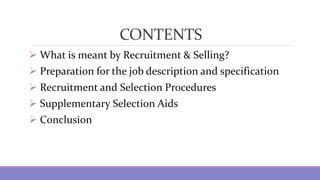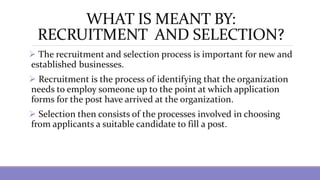Recruitment and selection
- 1. RECRUITMENT AND SELECTION BY: JARIYAPORN SEENAY LI MA
- 2. CONTENTS What is meant by Recruitment & Selling? Preparation for the job description and specification Recruitment and Selection Procedures Supplementary Selection Aids Conclusion
- 3. WHAT IS MEANT BY: RECRUITMENT AND SELECTION? The recruitment and selection process is important for new and established businesses. Recruitment is the process of identifying that the organization needs to employ someone up to the point at which application forms for the post have arrived at the organization. Selection then consists of the processes involved in choosing from applicants a suitable candidate to fill a post.
- 4. PREPARATION FOR JOB DESCRIPTION AND SPECIFICATION An accurate job description should be stated by the sales manages as she/he has knowledge of what is required. Generally, a job description will include: Title of the job Duties and responsibilities To whom they will report Technical Requirements Location and geographical area to be covered Degree of autonomy
- 5. RECRUITMENT AND SELECTION PROCEDURES The recruitment and selection process is important for new and established businesses There are several pieces to the recruitment and selection process: Sourcing candidates, Reviewing and tracking applicants, Conducting interviews and Selection for employment.
- 6. RECRUITMENT AND SELECTION PROCEDURES: STEP 1 – SOURCING CANDIDATES The first step in the recruitment and selection process. “Sourcing candidates” means your employment specialist is using a variety of methods to find suitable candidates for job vacancies. Can be done through online advertising on job and career sites or professional networking and participation in trade associations.
- 7. RECRUITMENT AND SELECTION PROCEDURES: STEP 2 – TRACKING APPLICANTS The next steps in the recruitment and selection process are: Tracking applicants and applications. Reviewing resumes. Applicant tracking systems (ATS) are becoming extremely helpful to employers. This technology aids in the management of job vacancies and applications for every open position. Employment specialists use ATSs to review applications and resumes.
- 8. RECRUITMENT AND SELECTION PROCEDURES: STEP 3 – PRELIMINARY PHONE INTERVIEW It is essential to conduct a phone interview to obtaining information about the applicant’s: Background, Work history Experience. The objective is to determine whether or not the applicant has the requisite skills and qualifications for the job vacancy
- 9. RECRUITMENT AND SELECTION PROCEDURES: STEP 4 – FACE-TO-FACE INTERVIEW SELECTION The hiring manager reviews the applications and resumes the employment specialist forwarded to him/her. The hiring manager invites the applicant to interview face-to-face; Communication about the interview and scheduling is generally handled by the employment specialist. This ensures that all qualified applicants receive the same information. At times, the employment specialist will prepare the applicant for the face-to-face interview. After the hiring manager interviews the applicant, she/he further narrows the field of candidates from which to select for the job opening.
- 10. RECRUITMENT AND SELECTION PROCEDURES: STEP 5 – EXTENDING AN EMPLOYMENT OFFER Once the hiring manager decides which candidate is most suitable for the job vacancy, they will inform the candidate of pre-employment matters, such as Background inquiries, Drug Tests If applicable, licensing information. When recruiting for positions where terms of employment are negotiated, compensation and benefits, and other issues, a draft employment offer may change hands from the candidate to the employer until the parties reach an agreement.
- 11. SUPPLEMENTARY SELECTION AIDS Some firms employ supplementary techniques to provide a valid measure of potential. Some of them are: Psychological Tests Role playing Even though these selection aids may help sales manages with hiring, there are a few disadvantages which are linked to using these methods.
- 12. SUPPLEMENTARY SELECTION AIDS: PSYCHOLOGY TEST The disadvantages are: Ease of deceiving: The applicant may have an idea of the traits of the type of person who is likely to be successful at selling. They tend to respond dishonest answers and passes the interview as they fake their answers to give the sales manager the kind of answer they’re looking for to give the right impression. Measures interest in applicant instead of their sales ability: Sales manages assume that sales success can be predicted by the type of interest the person has. Identify personality traits: Factors such as sociable, dominant, friendly and loyal a person are considered to predict sales success. However, they have failed to distinguish between high-performing and low-performing sales personnel. This is irrelevant to sales success as one’s personality may not be associated with sales success.
- 13. SUPPLEMENTARY SELECTION AIDS: ROLEPLAYING Sales managers role-play with their applicants in order to determine their selling potential. This involves placing them individually in a selling situation and assessing how well their perform. However, the downfall to this is that: It measures the sales ability of the candidate at that moment. Role playing cannot assess the candidate’s ability to establish and handle long-term relationships with buyers. Thus, this technique will only provide sales manages the information how their candidates will perform with short-term relationships with customers and one-time buyers.
- 14. CONCLUSION A company’s recruitment and selection process is the best way to achieve success in the business world. Sales managers should decide on the requirements of the job and the type of person who should be able to fulfill them. If a supplementary selection aid is to be used, there should be a guidance of a psychologist if they will use the psychology test. Implementing more effective processes to recruit candidates and select the best and the brightest; will improve one’s ability to meet one’s organization’s human resource needs.
- 15. THANK YOU! ! !















